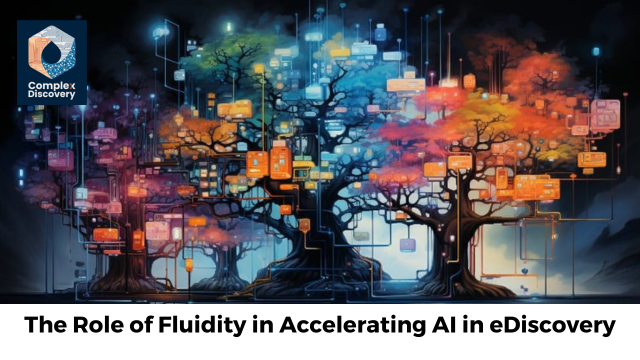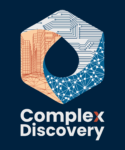
[EDRM Editor’s Note: This article was first published here on October 9, 2023 and EDRM is grateful to Rob Robinson, editor and managing director of ComplexDiscovery, for permission to republish.]

ComplexDiscovery Editor’s Note: This industry feature article explains how the fluidity between discovery, invention, and innovation enables a paradigm shift in considering legal technology products and services. Rather than linear steps, these knowledge states are increasingly seen as fluid phases that dynamically evolve amongst each other. This fluid nonlinearity opens new possibilities for AI to reinvent capabilities without incremental development. For example, generative AI could rapidly recombine innovations across workflows to synthesize novel applications, reinventing abilities through fluid knowledge transitions rather than pipelines. By embracing this fluid thinking, AI is positioned to accelerate transforming legal technology. The article suggests professionals should recognize the nonlinear convergence of AI and law, where recombining innovations, discoveries, and inventions will likely drive progress more than rigid sequences. Adjusting mindsets to leverage this fluid evolution of knowledge is key to unlocking AI’s fullest disruptive potential across legal technology services.
Industry Feature Article*
The Role of Fluidity in Accelerating AI in eDiscovery
ComplexDiscovery Staff
Discovery, invention, innovation. For decades, these concepts were viewed as distinct steps in a rigid linear pipeline. Research discovered new knowledge. Development invented applications. Production drove innovation to market. Knowledge flowed one way – from abstract ideas to commercial products.
But a paradigm shift is emerging. Discovery, invention, and innovation appear more akin to fluid states of knowledge, dynamically evolving amongst each other like phases of matter. Gas, liquid, solid. Concept, prototype, product. Knowledge can transition back and forth, with innovations leading to new discovery or old concepts sparking reinvention.
A prepared legal technology mind recognizes AI and law are proceeding on convergent nonlinear paths. Models reinvent capabilities as fluidly as the mutable precedents of common law. Dynamically combining innovations with discoveries and inventions may increasingly drive progress.
Rob Robinson, ComplexDiscovery
Many legal and legal technology futurists anticipate an inverted legal services pyramid where inexpensive general AI handles standard work before limited bespoke human effort. This potential inversion epitomizes flipped sequences and nonlinear advancement where AI thrives.
Recognizing this fluidity and nonlinearity holds exciting implications for artificial intelligence and legal technology. AI researchers and legal technologists have traditionally focused on building pipelines from data to insights to services and products. However, embracing the fluid evolution of knowledge opens new possibilities for leveraging AI and reinventing legal technology across services and products.
Take legal document review in eDiscovery. AI developed for eDiscovery innovation could enable discovering new capabilities ranging across the review workflow – from project management, technology and staffing specification, volume alignment, and quality control to advanced concepts like predictive coding and prioritized document ranking. Generative AI models may reinvent review plan development, staffing allocation, technology optimization, and quality validation processes. Or they may directly synthesize novel applications for workflow execution, ESI preparation, automated document promotion, review queue prioritization, results reporting, and beyond. By recombining innovations across the continuum of review planning, preparation, execution, and analysis, generative AI can reinvent and discover new abilities without incremental steps.
Similar nonlinear potential exists and is regularly exemplified beyond the law. One example is metformin’s winding journey. First synthesized in 1922, it was discovered effective for diabetes in the 1950s and innovated into an approved drug. But today, metformin is being rediscovered as a potential cancer therapy, reinventing knowledge of this nearly century-old molecule.
Legal technology is ripe for nonlinear thinking. The Electronic Discovery Reference Model (EDRM) emerged as a quasi-linear step-by-step process for eDiscovery. But as eDiscovery has matured, the EDRM has grown more fluid and nonlinear with iterative processes between steps and bidirectional information flows. AI can accelerate the evolution of the EDRM by rapidly recombining innovations, discoveries, and inventions across stages. This recombination approach reinforces the view of discovery, invention, and innovation as fluid states of knowledge rather than rigid pipelines. One example of an openness to changing information flows can be seen in the recently launched EDRM project to address the impacts of new document types, technologies, and workflows. This EDRM 2.0 project aims to reimagine and potentially update the iconic EDRM model for modern eDiscovery. By embracing nonlinear thinking and the fluid evolution of knowledge, this effort mirrors the paradigm shifts occurring within artificial intelligence research.
Likewise, knowledge evolves fluidly in other fields. Consider polymerase chain reaction (PCR) techniques for copying DNA. Foundational discovery of DNA replication enabled PCR’s invention, which later innovated into a transformative biotechnology. Yet new PCR techniques continue reinventing it, while discoveries around DNA polymerases persist. Knowledge evolves fluidly amongst discovery, invention, and innovation.
For data-driven AI, embracing this fluid cognitive process opens new frontiers. Researchers can view innovations as launching pads for discoveries, not endpoints. Old discoveries may spur reinvention or fast-track future innovation. Generative models are ideal for creatively recombining concepts across fluid knowledge states.
Yet embracing nonlinearity requires adjusting mindsets. Scientists traditionally move stepwise through the scientific method. Engineers progress in defined developmental stages toward commercialization. AI developers create pipelines flowing data to services and products. But real innovation often occurs via serendipity, reversing expected sequences.
Consider the initial discovery of penicillin in 1928. Contamination in a bacteria culture dish led to the surprise observation that mold inhibited bacterial growth. This chance finding overturned prevailing linear thinking to spawn the antibiotic era. As Louis Pasteur noted, “Chance favors the prepared mind.”
A prepared legal technology mind recognizes AI and law are proceeding on convergent nonlinear paths. Models reinvent capabilities as fluidly as the mutable precedents of common law. Dynamically combining innovations with discoveries and inventions may increasingly drive progress.
Many legal and legal technology futurists anticipate an inverted legal services pyramid where inexpensive general AI handles standard work before limited bespoke human effort. This potential inversion epitomizes flipped sequences and nonlinear advancement where AI thrives.
Of course, understanding the fluidity between discovery, invention, and innovation does not discount the need for some linear thinking in legal technology. Standard operating procedures and defined developmental steps remain essential in many cases. However, mindfulness of nonlinear possibilities will enable AI to reach its fullest disruptive potential across legal services and beyond.
In 1928, a scientist returned from vacation to a contaminated bacteria culture and made a discovery that reinvented antibiotic science. Today, researchers in law and AI stand on the cusp of similar nonlinear breakthroughs. But first, they must embrace the fluidity and nonlinearity of knowledge creation. With open minds, transformative advances await at this convergence of technology and the law.
*Developed from an Open Access article by Suxiang Chen, distributed under CC BY 4.0. (1)
End Notes
- Chen, S. (2022). Discovery, invention, and innovation: Are they really different? Academia Letters, Article 4747. https://doi.org/10.20935/AL4747
- EDRM. (2023). Current EDRM Model. Retrieved October 8, 2023, from https://edrm.net/edrm-model/current/
- Robinson, R. (2023, March 22). A Refreshing Update? EDRM Launches Project to Update Iconic Model. Rob Robinson. Retrieved October 8, 2023, from https://complexdiscovery.com/a-refreshing-update-edrm-launches-project-to-update-iconic-model/
Assisted by GAI and LLM Technologies per EDRM GAI and LLM Policy.
Additional Reading
- eDiscovery Survey Archives of ComplexDiscovery
- eDisclosure Systems Buyers Guide – Online Knowledge Base
Source: ComplexDiscovery


